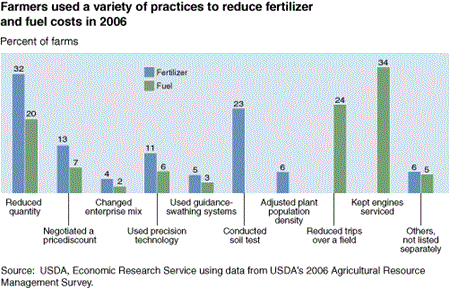Farmers Develop Strategies To Reduce Energy Input Costs

Between 2002 and 2008, fuel and fertilizer prices rose sharply, thereby contributing to substantially higher total farm energy-intensive input costs. During this time, inflation-adjusted annual average prices paid by farmers for fuel (including diesel, gasoline/ gasohol, and liquefied petroleum) rose by 182 percent, and annual average prices paid by farmers for mixed fertilizers (nitrogen, phosphate, and potash) increased by 202 percent. Across all farms, fertilizer and fuel costs averaged 12 percent of production expenses. For corn, soybean, wheat, and cotton farms, however, fertilizer and fuel costs averaged more than 20 percent of total expenses. Consequently, steep increases in energy-related costs have had a greater impact on farms producing these four crops.
The escalation in energy prices prompted farmers to develop energy-saving strategies and to adopt practices to use energy-intensive inputs more efficiently. USDA's 2006 Agricultural Resource Management Survey asked farmers about their use of energy-saving strategies. According to the results of the survey, about a fourth of all U.S. farms reduced energy use or employed energy-intensive inputs more efficiently.
Commercial farms were more likely to initiate steps to reduce energy-related costs. Farms that developed energy-saving strategies tended to have higher per acre fertilizer, fuel, and other energy-related input expenses, and their operators were younger and more educated than operators of farms that did not take steps to reduce energy costs. Practices adopted to reduce fertilizer expenses, in declining order of frequency of use, included reducing the quantity of input, conducting soil tests, employing precision technologies (for fertilizer, pesticide, and seed applications), and negotiating price discounts. More than half of farmers who negotiated discounts were able to reduce fertilizer prices by at least 5 percent.
The most common practices used to lower fuel expenses were keeping engines properly serviced, making fewer trips over a field, and reducing the quantity of fuel used. About 40 percent of farmers who negotiated fuel price discounts were able to reduce fuel prices by at least 5 percent.
Agricultural Income and Finance Outlook, USDA, Economic Research Service, December 2008, Agricultural Income and Finance Outlook, AIS-86, USDA, Economic Research Service, December 2008.


